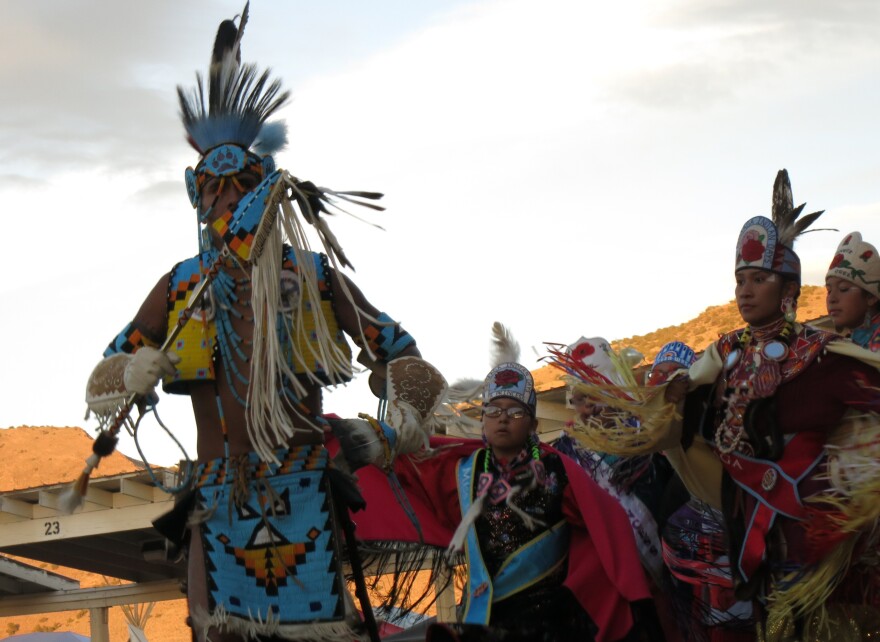Native American tribes from across the country met this weekend to celebrate culture, life and family at the Numaga Indian Days Powwow in Hungry Valley. As Reno Public Radio’s Noah Glick reports, these events have a long historical and cultural background.
Among pulsing drums and tribal song, dozens of people donned their traditional native regalia and danced in step to the beat.
This tradition is part of the powwow’s grand entry, which honors relatives who have passed, elders and tribes in attendance, and veterans of war.

Powwows began centuries ago, as a way for tribes to meet with one another and trade goods and materials. Back then, it took days for members of various tribes to reach their destination.
Stacy Montooth is spokesperson for the Reno-Sparks Indian Colony. She says the significance behind these inter-tribal meetings remains today.
“Because they didn’t take place very often, it was a big darn deal when we got together with other tribes," Montooth says. "So even in 2016, any time you get native people together, there’s always these common elements: prayer, song, the drum, food.”
Montooth says the drum represents the heartbeat, which acts as the life blood of the dance. Drummer Toby Stump agrees.
“There’s a lot of togetherness which is the drum being the beat for the type of song," he says. "Without the drum, there’s no dancing. And without no dancers there’s no drum.”

Elizabeth Works has been going to powwows as long as she can remember—and dancing has always been a major part of it for her.
“I’ve been dancing since I could walk," she says. "But I’m almost 50 and even now I still get anxious and kind of nervous. But we don’t dance just to compete, our family’s out there and we love to dance.”
Works says dancing has always been a part of Native American gatherings and ceremonies, because there’s a significant meaning to it.
“We’ve always been taught to dance for the people who can’t dance, for the people who can’t be here, for those who have passed on,” she says.
That takes us into a little bit of history. You see, before the American Indian Religious Freedom Act was passed in 1978, it was technically illegal for Native Americans to gather in any sort of ceremony, which includes dancing. This is partly why the practice is seen as so important today.
Works’ husband, who goes by his native name, Kwassuh, says the impact of these types of laws have led many native people to give up their traditional ways of life, instead opting for easier, more modern ways of doing things.
“So nobody knows how to hunt right, nobody knows what to do with the hide. So what happens is that when you go out there, and you’re going to notice a lot of dancers are wearing cloth. That’s because nobody has access to hides anymore.”
Other changes can be seen within the powwow’s competitions. Along with beauty pageants and various dancing contests, there’s a drum competition with a $10,000 cash prize.

While many young people like this idea, others aren’t so excited about it, like elder Lorren Sammaripa of the Walker River Paiute Tribe.
“Money causes a lot of difficulties among our people, anybody’s people," Sammaripa says. "They get greedy. The more they make, the more they want.”
Sammaripa says that competitions at powwows have been around since the beginning, but the motivation for cash is new. This, he says has changed the atmosphere and even the way people dress.
“A vest is a vest, that’s the way it used to be in the old days," he says. "Now they come out with beadwork and everything’s flashy.”
While technology and competitions have evolved over the years, Sammaripa says the powwow is still about sharing culture and ideas with family.
“This outfit my grandson behind you is wearing is over 52 years old," he says. "That was my son’s outfit when he was a fancy dancer. Now my grandson is growing up to fit it. It will just continue down the line.”
And as Kwassuh says, the spiritual nature of these events will never change.
“It’s a family environment, but we all give thanks to the Great Spirit," he says. "And it’s bringing our materials to life.”
Check out our photos and video from the event below:


https://www.youtube.com/watch?v=JeosaA75q78&feature=youtu.be





